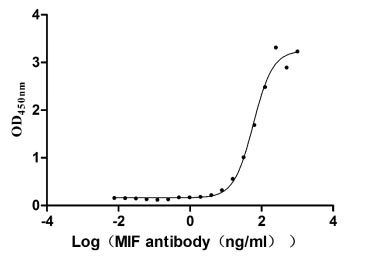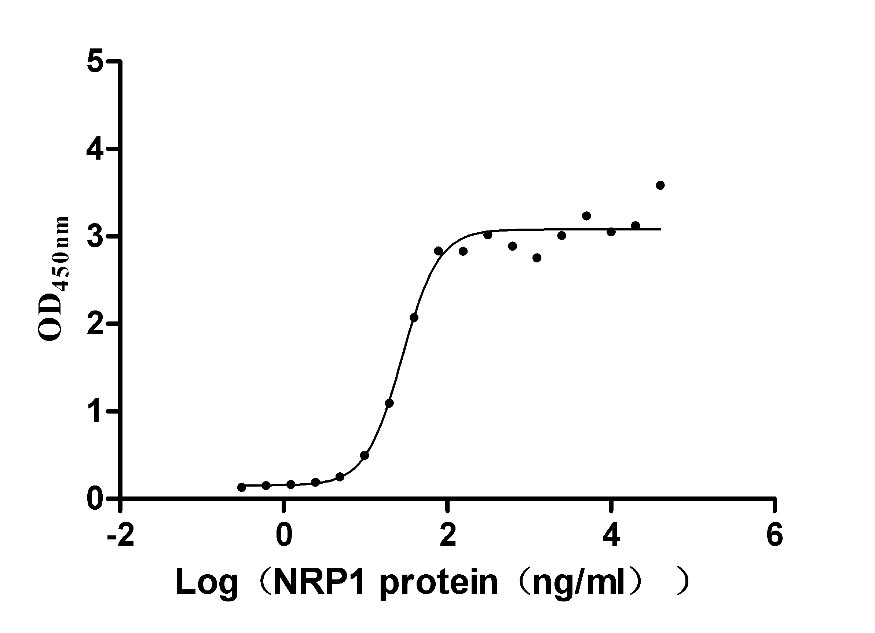Recombinant Human B-cell receptor CD22 (CD22), partial
-
货号:CSB-YP004900HU
-
规格:
-
来源:Yeast
-
其他:
-
货号:CSB-EP004900HU-B
-
规格:
-
来源:E.coli
-
共轭:Avi-tag Biotinylated
E. coli biotin ligase (BirA) is highly specific in covalently attaching biotin to the 15 amino acid AviTag peptide. This recombinant protein was biotinylated in vivo by AviTag-BirA technology, which method is BriA catalyzes amide linkage between the biotin and the specific lysine of the AviTag.
-
其他:
-
货号:CSB-BP004900HU
-
规格:
-
来源:Baculovirus
-
其他:
产品详情
-
纯度:>85% (SDS-PAGE)
-
基因名:
-
Uniprot No.:
-
别名:B cell receptor CD22 precursor; B lymphocyte cell adhesion molecule; B-cell receptor CD22; B-lymphocyte cell adhesion molecule; BL CAM; BL-CAM; BLCAM; CD 22; CD22; CD22 antigen; CD22 molecule; CD22 protein; CD22_HUMAN; Lectin 2; Leu14; Lyb8; MGC130020; sialic acid binding Ig like lectin 2; Sialic acid binding immunoglobulin like lectin 2; Sialic acid-binding Ig-like lectin 2; SIGLEC 2; Siglec-2; SIGLEC2; T cell surface antigen Leu 14; T-cell surface antigen Leu-14
-
种属:Homo sapiens (Human)
-
蛋白长度:Partial
-
蛋白标签:Tag type will be determined during the manufacturing process.
The tag type will be determined during production process. If you have specified tag type, please tell us and we will develop the specified tag preferentially. -
产品提供形式:Lyophilized powder
Note: We will preferentially ship the format that we have in stock, however, if you have any special requirement for the format, please remark your requirement when placing the order, we will prepare according to your demand. -
复溶:We recommend that this vial be briefly centrifuged prior to opening to bring the contents to the bottom. Please reconstitute protein in deionized sterile water to a concentration of 0.1-1.0 mg/mL.We recommend to add 5-50% of glycerol (final concentration) and aliquot for long-term storage at -20℃/-80℃. Our default final concentration of glycerol is 50%. Customers could use it as reference.
-
储存条件:Store at -20°C/-80°C upon receipt, aliquoting is necessary for mutiple use. Avoid repeated freeze-thaw cycles.
-
保质期:The shelf life is related to many factors, storage state, buffer ingredients, storage temperature and the stability of the protein itself.
Generally, the shelf life of liquid form is 6 months at -20°C/-80°C. The shelf life of lyophilized form is 12 months at -20°C/-80°C. -
货期:Delivery time may differ from different purchasing way or location, please kindly consult your local distributors for specific delivery time.Note: All of our proteins are default shipped with normal blue ice packs, if you request to ship with dry ice, please communicate with us in advance and extra fees will be charged.
-
注意事项:Repeated freezing and thawing is not recommended. Store working aliquots at 4°C for up to one week.
-
Datasheet :Please contact us to get it.
相关产品
靶点详情
-
功能:Mediates B-cell B-cell interactions. May be involved in the localization of B-cells in lymphoid tissues. Binds sialylated glycoproteins; one of which is CD45. Preferentially binds to alpha-2,6-linked sialic acid. The sialic acid recognition site can be masked by cis interactions with sialic acids on the same cell surface. Upon ligand induced tyrosine phosphorylation in the immune response seems to be involved in regulation of B-cell antigen receptor signaling. Plays a role in positive regulation through interaction with Src family tyrosine kinases and may also act as an inhibitory receptor by recruiting cytoplasmic phosphatases via their SH2 domains that block signal transduction through dephosphorylation of signaling molecules.
-
基因功能参考文献:
- Conjugates of these multivalent ligands with auristatin and saporin toxins are efficiently internalized via hCD22 resulting in killing of B-cell lymphoma cells PMID: 28829594
- This is the first time a NMR-based binding study of high affinity Siglec-2 (CD22) ligands in complex with whole Burkitt's lymphoma Daudi cells has been described. PMID: 27808110
- Here the s structurally characterize the ectodomain of CD22 and present its crystal structure with the bound therapeutic antibody epratuzumab, which gives insights into the mechanism of inhibition of B-cell activation. PMID: 28970495
- hCD22 transgenic mice develop normal humoral responses in a peanut allergy oral sensitization model. Homing of B cells to Peyer's patches was partially rescued by expression of hCD22 compared with CD22(-/-) B cells, although not to wild-type levels. PMID: 28972089
- Diabody-based (177)Lu-radioimmunoconjugate for CD22-directed radioimmunotherapy reduced disease burden in a non-Hodgkin lymphoma mouse model. PMID: 27524505
- Siglec-1 and Siglec-2 are potential biomarkers in autoimmune disease. (Review) PMID: 26752092
- We aimed to screen exons 9-14 of the CD22 gene, which is a mutational hot spot region in B-precursor acute lymphoblastic leukemia (pre-B ALL) patients. Nine variants, of which two novel, were found. Novel variants were in introns 10 and 13. Gly745Asp (rs10406069) variant was missense and Cys790Arg (rs79438722) variant was silent. PMID: 27486888
- Anti-CD22-magnetic nanoparticles-doxorubicin inhibited the proliferation of Raji cells, significantly increased the uptake of doxorubicin, and induced apoptosis. PMID: 26379425
- results demonstrate that loss of high affinity CD22 ligands on GC B-cells occurs in both mice and humans through alternative mechanisms, unmasking CD22 relative to naive and memory B-cells PMID: 26507663
- MicroRNA-19a and CD22 Comprise a Feedback Loop for B Cell Response in Sepsis. PMID: 26017478
- These results suggest that the in vivo mechanism of non-ligand-blocking epratuzumab may, in part, involve the unmasking of CD22 to facilitate the trans-interaction of B cells with vascular endothelium. PMID: 25484043
- By using integrative genomics and analysing the relationships of COPD phenotypes with SNPs and gene expression in lung tissue, we identified CST3 and CD22 as potential causal genes for airflow obstruction. PMID: 25182044
- study detected the expression of CD22 and CD72 on B cells of myasthenia gravis, compared to multiple sclerosis patient controls and healthy controls y PMID: 23184497
- In the absence of functional CD22, B cells have a "hyperactivated" phenotype, CD22 dysfunction could contribute to the pathogenesis of autoimmune diseases. (Review) PMID: 23083346
- The finding that CD22 is expressed on lung cancer cells is significant in revealing a heretofore unknown mechanism of tumorigenesis and metastasis PMID: 22986740
- Anti-CD22 recombinant immunotoxin moxetumomab pasudotox has activity in relapsed/refractory hairy cell leukemia. PMID: 22355053
- Our study implicates the CD22DeltaE12 genetic defect in the aggressive biology of relapsed or therapy-refractory paediatric B-lineage ALL. PMID: 22017452
- This CD22-targeted polymer carrier may be useful for siRNA delivery to lymphoma cells. PMID: 21629223
- Taken together, these results suggest that negative regulation of TLR signaling of B cells is an intrinsic property of CD22. PMID: 21178327
- The efficacy of a ligand-targeting approach to B cell-specific depletion therapy for cancer may be the ability of CD22 to recycle and accumulate ligand-decorated cargo intracellularly, as an endocytic receptor. PMID: 21178016
- These striking findings implicate CD22DeltaE12 as a previously undescribed pathogenic mechanism in human B-precursor leukemia. PMID: 20841423
- B cell surface receptors CD20 and CD22 are significantly affected in patients with SLE, pointing to their possible involvement in the aetiopathogenesis of the disease and in the regulatory mechanisms in response to the immune disturbance. PMID: 20726320
- The B-cell receptor IgM was found to be a major in situ trans ligand of CD22. PMID: 20172905
- Data show that anti-CD22 autoantibodies were positive in 80% of TSK/+ mice and in 22% of SSc patients. PMID: 19919568
- The Lyn/CD22/SHP-1 pathway is important in autoimmunity. Naive and tolerant B-cells differ in their calcium signaling in response to antigenic stimulation. PMID: 11826756
- Disulfide bonds and the resulting 3D conformation of the CD22 molecules may have important roles in the difference of antigenicity of CD22 beta in B cells and basophils PMID: 11882357
- ligand-binding of CD22 influences its intracellular signaling domain and is needed for inhibition of the B cell receptor signal PMID: 11994426
- masking of the alpha2-6-linked sialic acid binding site of CD22 involves many cell surface sialoglycoproteins, without requiring specific ligand(s) and/or is mediated by secondary interactions with Sias on CD45 and sIgM PMID: 15240561
- Aberrant CD22 expression is a useful marker for detection of monoclonal B cells admixed with numerous benign polyclonal B cells PMID: 15899772
- decreased CD22 expression may be associated with the activation of B cells in Bullous pemphigoid (BP), but not associated with BP-specific antibody production PMID: 17055225
- study showed that a synonymous SNP in CD22, c.2304C > A, was significantly associated with susceptibility to limited cutaneous systemic sclerosis PMID: 17493148
- The results suggest that these two siglec proteins have evolved distinct endocytic mechanisms consistent with roles in cell signaling and innate immunity. PMID: 17562860
- These results indicate that the alpha2-6-sialylated 6-sulfo-LacNAc determinant serves as an endogenous ligand for human CD22 and suggest the possibility that 6-GlcNAc sulfation as well as alpha2-6-sialylation may regulate Siglec-2 functions in humans. PMID: 17728258
- SAP is inducibly expressed in the human BJAB cells, and co-localizes and interacts with CD22. SAP binding to the inhibitory immunoreceptor CD22 regulates calcium mobilization in B cells. PMID: 19150402
显示更多
收起更多
-
亚细胞定位:Cell membrane; Single-pass type I membrane protein.
-
蛋白家族:Immunoglobulin superfamily, SIGLEC (sialic acid binding Ig-like lectin) family
-
组织特异性:B-lymphocytes.
-
数据库链接:
HGNC: 1643
OMIM: 107266
KEGG: hsa:933
STRING: 9606.ENSP00000085219
UniGene: Hs.579691
Most popular with customers
-
Recombinant Human Macrophage migration inhibitory factor (MIF) (Active)
Express system: Mammalian cell
Species: Homo sapiens (Human)
-
Recombinant Macaca fascicularis Delta-like protein 3 (DLL3), partial (Active)
Express system: Mammalian cell
Species: Macaca fascicularis (Crab-eating macaque) (Cynomolgus monkey)
-
Recombinant Human Neuropilin-1 (NRP1) (Active)
Express system: Mammalian cell
Species: Homo sapiens (Human)
-
Recombinant Human C-C chemokine receptor type 5 (CCR5)-VLPs
Express system: Mammalian cell
Species: Homo sapiens (Human)
















